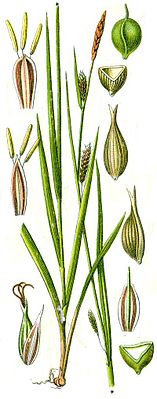Smooth sedge
| Smooth sedge | ||||||||||||
|---|---|---|---|---|---|---|---|---|---|---|---|---|

Smooth sedge ( Carex laevigata ), illustration |
||||||||||||
| Systematics | ||||||||||||
|
||||||||||||
| Scientific name | ||||||||||||
| Carex laevigata | ||||||||||||
| Sm. |
The smooth sedge ( Carex laevigata ) is a species of the sedge ( Carex ).
description
The smooth sedge is a perennial herbaceous plant and reaches stature heights of 50 to 90 (rarely 120) centimeters. It forms short runners . The stems are erect or ascending, triangular, smooth, and have leaves. The leaves are sometimes over 10 mm wide, light green, smooth and shorter than the stem. They have a long ligule . The abdominal vaginal wall has a dry-skinned appendage. The basal leaf sheaths are shiny yellow-brown.
The flowering time is in April and May. The smooth sedge is a variegated sedge. There is one male spikelet , rarely two. The three or four female spikelets are densely flowered and sometimes over 3 inches long, at most five times as long as they are wide. They stand upright, the lower ones nodding slightly. All spikelets are petiolate and distant. Their stems are not enclosed by the bracts . They have long sheaths and are shorter than the inflorescences. The bracts are red-brown and have a green central stripe. They are lanceolate, pointed and slightly shorter than the fruit. The stylus has three scars .
The fruit is 4 to 5 millimeters long, glabrous and multi-veined. It is ovoid and biconvex and slowly narrows into the beak. The beak is finely serrated at the edges, bald and has two bristle tips.
The number of chromosomes is 2n = 72.
Occurrence
The distribution area of the smooth sedge stretches from western and southwestern Europe to Scotland and also southern Italy to Sicily and northwestern Morocco. The species is a submeridional to temperate, euoceanic floral element . It occurs mainly in Western Europe and extends to the West Eifel, Schneeeifel, Venn, Hunsrück and Westerwald. It grows in alder forests and willow swamps. It is a characteristic species of Sphagno-Alnetum.
literature
- Rudolf Schubert , Klaus Werner, Hermann Meusel (eds.): Excursion flora for the areas of the GDR and the FRG . Founded by Werner Rothmaler. 13th edition. tape 2 : vascular plants . People and knowledge, Berlin 1987, ISBN 3-06-012539-2 (area).
- Siegmund Seybold (Ed.): Schmeil-Fitschen interactive . CD-ROM, version 1.1. Quelle & Meyer, Wiebelsheim 2002, ISBN 3-494-01327-6 .
Individual evidence
- ↑ a b Erich Oberdorfer : Plant-sociological excursion flora for Germany and neighboring areas . With the collaboration of Angelika Schwabe and Theo Müller. 8th, heavily revised and expanded edition. Eugen Ulmer, Stuttgart (Hohenheim) 2001, ISBN 3-8001-3131-5 , pp. 190 .
- ↑ Rafaël Govaerts (ed.): Carex laevigata. In: World Checklist of Selected Plant Families (WCSP) - The Board of Trustees of the Royal Botanic Gardens, Kew . Retrieved October 21, 2016.
Web links
- Carex laevigata Sm., Smooth sedge. In: FloraWeb.de.
- Smooth sedge . In: BiolFlor, the database of biological-ecological characteristics of the flora of Germany.
- Distribution in the Netherlands. (Dutch)
- Thomas Meyer: Data sheet with identification key and photos at Flora-de: Flora von Deutschland (old name of the website: Flowers in Swabia )
- Photos: [1] , inflorescences , [2] , [3]